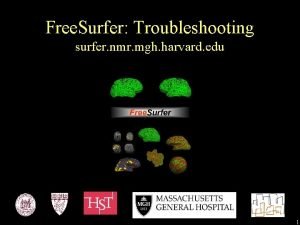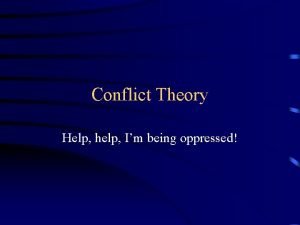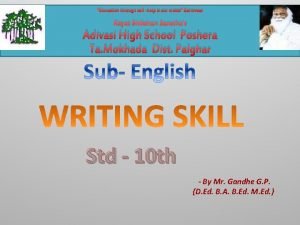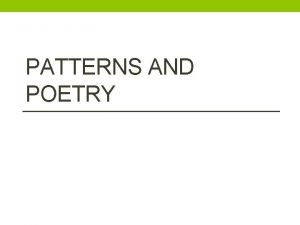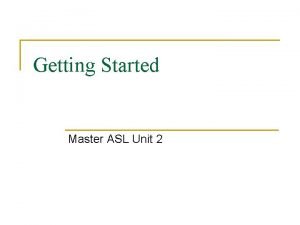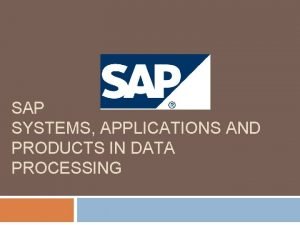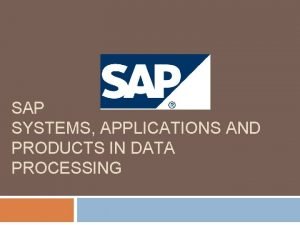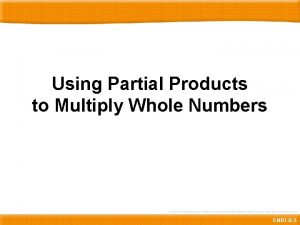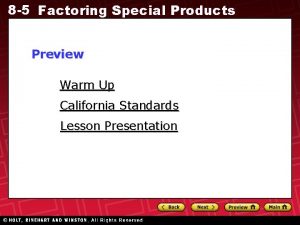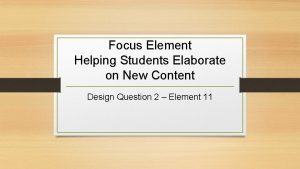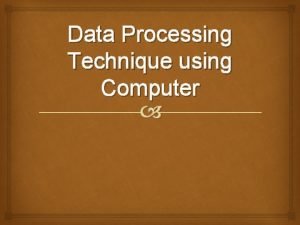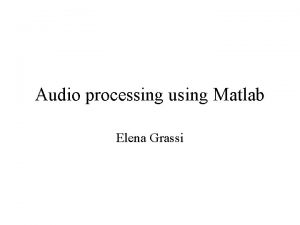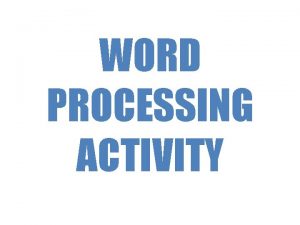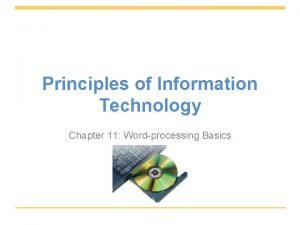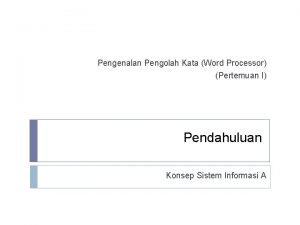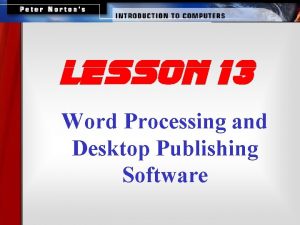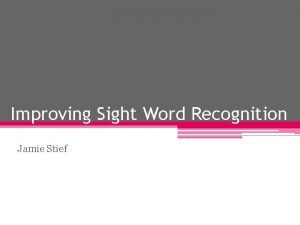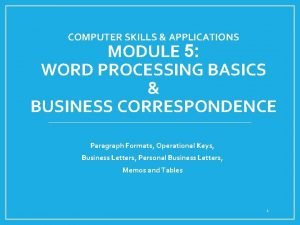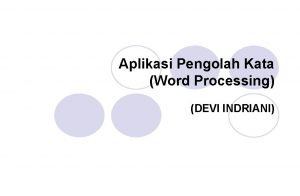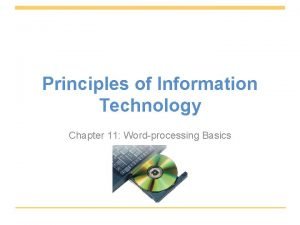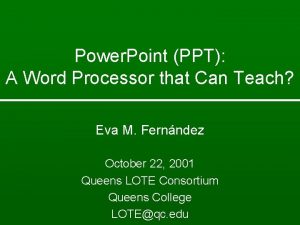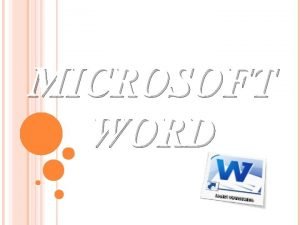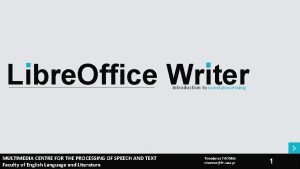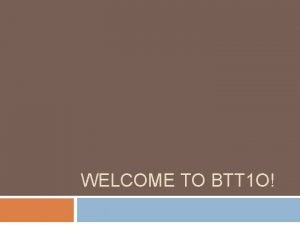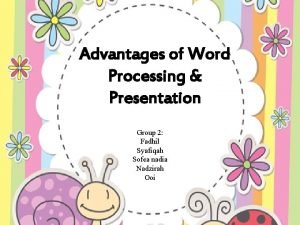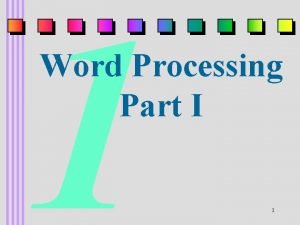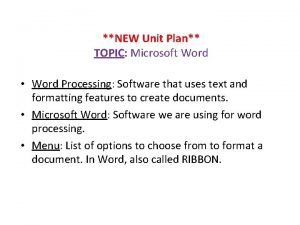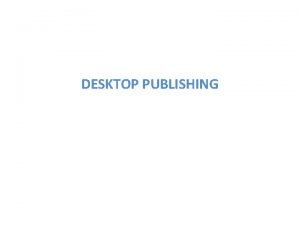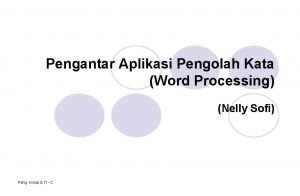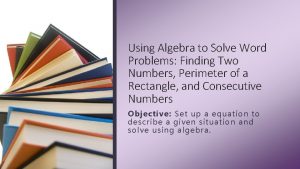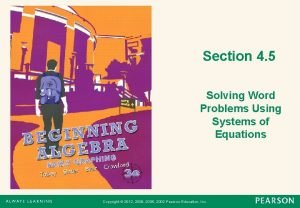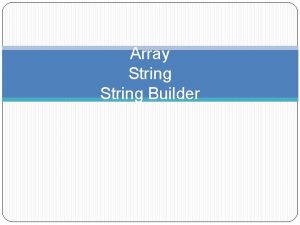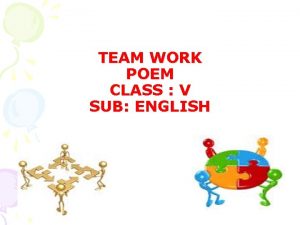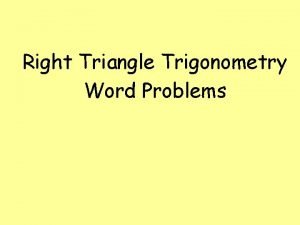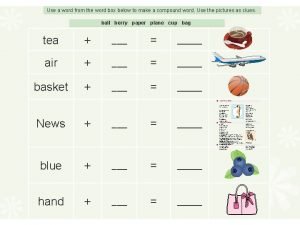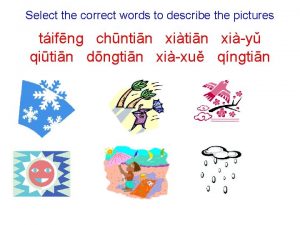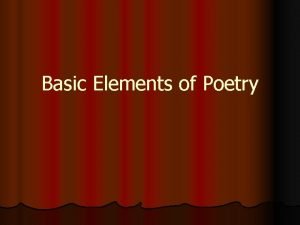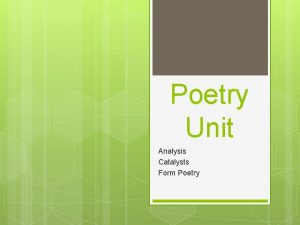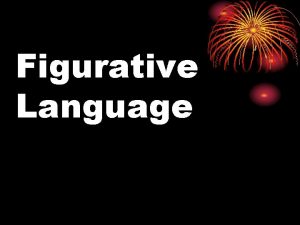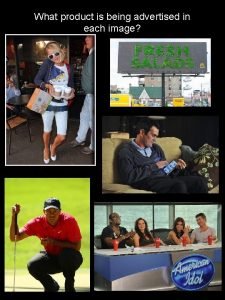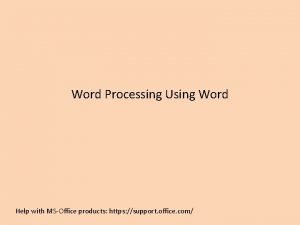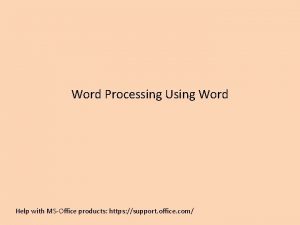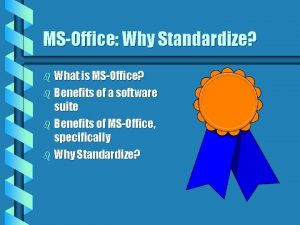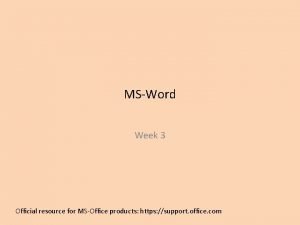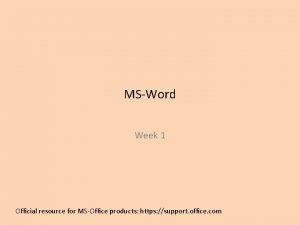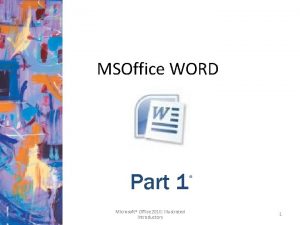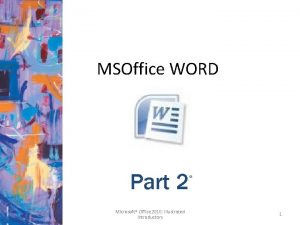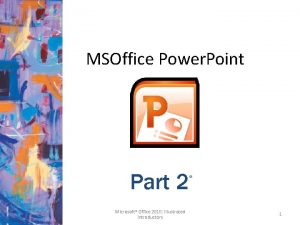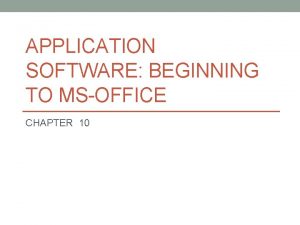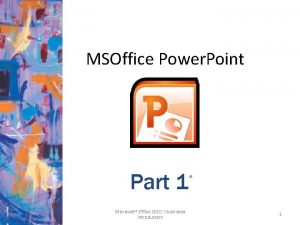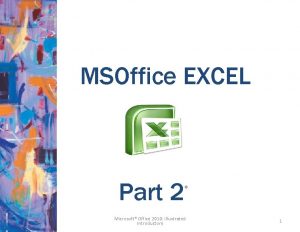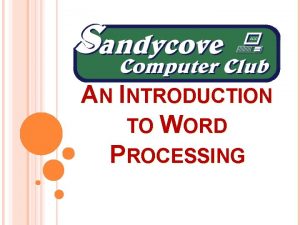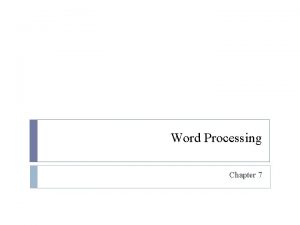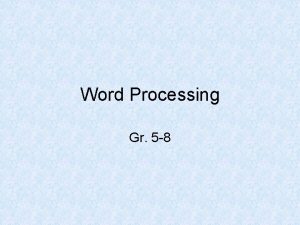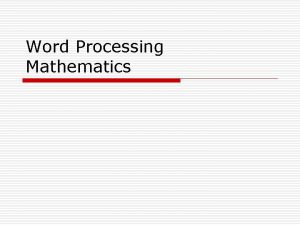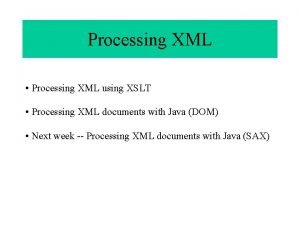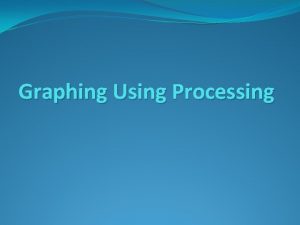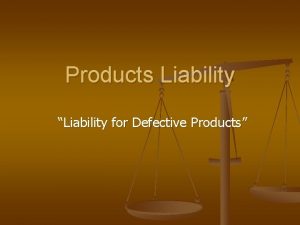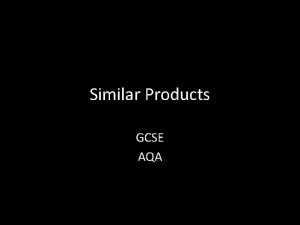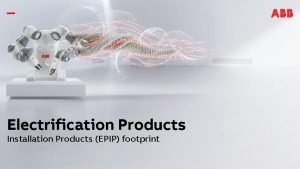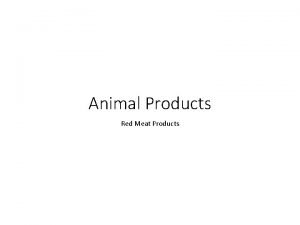Word Processing Using Word Help with MSOffice products































































- Slides: 63

Word Processing Using Word Help with MS-Office products: https: //support. office. com/

What You Already Know (Some Features Of Word) • • • Starting Word / Quitting Word Creating a new document Entering, deleting text along with simple edits Copy/cut pasting of text Saving a document Spell checking a document Printing documents Etc. For more information for catching up see the notes: – “Word and basic features”

Microsoft: Word Resources • Basics (will help you catch up if needed and learn more advanced features) • https: //support. office. com/en-us/article/create-a-document-in-word-2016 -aafc 163 a-3 a 06 -45 a 9 -b 451 cb 7250 dcbaa 1 • Research, edit, and design (e. g. styles and themes) – https: //support. office. com/en-us/article/research-edit-and-design-in-word-2016 -bc 819 ecd-9887 -4 a 158 eda-d 90 cbc 58 f 8 fb • Collaborating using Word – https: //support. office. com/en-us/article/collaborate-in-word-2016 -b 3 d 7 f 2 af-c 6 e 9 -46 e 7 -96 a 7 dabda 4423 dd 7 • Training videos – https: //support. office. com/en-us/article/word-for-windows-training-7 bcd 85 e 6 -2 c 3 d-4 c 3 c-a 2 a 55 ed 8847 eae 73? ui=en-US&rs=en-US&ad=US • MAC help (recall though this is not a MAC-specific course) – https: //support. office. com/en-us/article/word-2016 -for-mac-help-c 3292414 -89 c 0 -46 e 5 -82 a 7 d 55 a 1720 f 3 bd

MS-Office • There’s different ways of completing the same task – Alternatives make things easier for the user (different people may find one way more intuitive than another) e. g. fonts and font effects – Example: choosing fonts and font effects • For this course and in “real life” one way isn’t better than another (just learn *a* way that works)

Exam Questions • Assignments will require you to invoke different features of Word – So you will learn how/where to run those features • Exams: because they will be on paper and not in front of the computer – The focus will be on how different features of Word work over “where you have to click” in order to run those features. – Sample exam question (relatively easy): Refer to the line of text “The cat in the cat”. The entire line is selected and the bold toggle feature is run (e. g. selecting the feature in the ribbon or by right clicking on the text etc. ). What is the result? a) b) c) d) ‘Cat’ is bolded ‘Cat’ is unbolded The entire line is unbolded

Inserting Page Breaks • Insert->Page Break • Moves text after the page break to the top of the next page • This is not the same as a hard return (hitting the ‘enter’) key

Inserting A Section Break • Sections in a document can have different formatting applied or have it’s own sequence of page numbering • Sections can be on different pages or reside on the same page. • (Section breaks are actually not ‘inserted’ into a Word document). – Change layout • Sections on different page – Layout->Breaks->Next page • Sections on same page – Layout->Breaks->Continuous

5. Insertions: Symbols & Equations • A useful time saver: – Symbols • Insert->(Symbols group: Symbols) – Equations • Insert->(Symbols group: Equations)

Show/Hide Formatting Symbols • Some characters (e. g. formatting) affect formatting but have no visible appearance (e. g. space, tab etc. ) View formatting symbols • Formatting symbols (tabs vs. spaces)

Sometimes Seeing Formatting Symbols Can Be Useful • Why can’t Row 2 resize

Text Styles • Home->(‘Styles’ group) • Styles have pre-defined fonts, font sizes and font effects which can be applied with a single click. • Word comes with pre-defined styles that can be applied to text. • New styles can also be pre-defined • Some documents may be formatted (e. g. margins, spacing, fonts, font effects etc. ) to conform to common writing styles: – APA template: • https: //templates. office. com/en-US/APA-style-report-6 th-edition-TM 03982351

The Format Painter • A shortcut to using styles is the format painter (copy-paste formatting) – Home->Clipboard group: Format painter

Finding Text In A Document • This is one of the major advantage for having an electronic vs. paper version. – Example: “Where in this giant section of notes did Tam talk about ‘inserting’ things into Word” • Shortcut: Press both keys (same time or one after another without releasing the first) – Home->Editing group: Find (or Replace) – Styles can even be ‘found’ and replaced – <Ctrl>-<f>

Working With Tables (Basics Are Assumed Knowledge) • Creating a new table – Insert->Table • Tables in Word allow for simple (as compared to a spreadsheet such as Excel) calculations to be performed – Layout (new tab on far right)->(Data group: formula)

Table Formulas To Know For The Exam • • Average(<direction>) Max(<direction>) Min(<direction>) Sum(<direction>) • Directions: above, below, left, right • Example (created via: Layout->(Data group: Formula) & inserting into Row 4, Column 1): Inserted formula =sum(left) Inserted formula =average(above)

Note: Inserting Formulas Via Running a Feature In The Ribbon Vs. Typing • With the previous example and the data in the first three rows: • Selecting the 4 th row and directly typing in there ‘=sum(above)’ will have the result be treated as text and yield:

Sub-Section: References • • • Table of contents Bibliography Citations Captions Foot/end notes

Table Of Contents (What You Need Before Inserting One) • The ‘Heading’ styles must be used (or a new style created that is derived from either Heading 1 or Heading 2). • That is because the headings (and sub headings) in the document will be used to form the table of contents.

Table Of Contents • In Word – References->Table of Contents->(Select the type of table: For A 1 it’s “Automatic Table 2”)

Citation • Step 1: Create the citation (enter information regarding the source or citation) – Creating citation in Word: • References->Insert Citation->Add New Source – (If you need to change the citation later): • References->Insert Citation->Manage Sources->Select the citation->Edit

Step 1: Create the citation (2) • Step 1: Create the citation (continued) – Entering the information for the (source of the) citation e. g. “Film”

Citation (2) • Step 2: Using or referring to the citation – Navigate to the location in Word where the citation will be located – Insert the citation at that location: • References->Insert Citation->(Select the citation source from the list)

Bibliography • The above bibliography was created from the previous citation. • In Word – For A 1: References->Bibliography->(Select Bibliography)

(Image) Captions • Via the Word Ribbon: – References->Insertion Caption

(Image) Captions (2) • Via Right-click in Word – Select image – Right click – Select “Insertion caption”

Cross References • Text that refers to items in the document such as figures and tables. • Step 1: Caption the image (previous slide) • Step 2: Insert the caption that refers to the image • References->Cross Reference->(Select the type of reference: Figure)>(Select the figure being referenced)

Footnotes And Endnotes • Footnote – Appear at the end of the page – Step 1: Navigate to the location where the footnote will appear – Step 2: References->Insert Footnote – Step 3: Enter the information for the footnote (appears at bottom of page) • Endnote – Appear at the end of the document – Step 2: References->Insert Endnote – All other steps are the same

Automatically Generating References & Captions (Word) • Q: Why not just type them in manually? • Consider if changes must be made – Add new sections in a document (table of contents must be updated) • Although not required for A 1 consider also if cross references were used. – A new image for a figure and a caption is added in the middle of a document (other captions may have text that refer to the particular figure and figure number). • For these reasons expect that no credit will be earned for the assignment if you manually type in information such as a table of contents or figure captions.

Recap Of This Section: Things You Should Now Know • How to run (although not for the exam) the following features of Word as well as how they work (know for the exam) – Inserting a table of contents – Creating new citations, inserting citations – Creating a bibliography from citations – Inserting image captions, creating cross references – Inserting footnotes and endnotes

Sub-Section: Mail Merge

Mail Merge: How It Works • Combines information from a main document (a Word document sometimes referred to as the ‘starting document’) with a data source (e. g. Excel spreadsheet, Access database sometimes referred to as the ‘recipients’ list). • The information specified in the main document stays the same (e. g. a form letter) whereas the data source provides the customized information. • Example customizations (non-exhaustive list): – Letters & emails – Envelopes – Labels

Mail Merge: • Example: – Folder name: mail_merge_example – Starting files in the folder: • starting_recipient_list (Excel file) • starting_letter (Word document) – Products of the merge in the folder: • merged_letter • step 6_completed_merged_letters

Example Mail Merge Process Main document Merged document << Address >> Dear <<Title>> <<Last Name>>, U of C Dear Bottlewasher Tam, Congratulations, you won a prize! Congratulations you won a prize! Sincerely, Mr. Smith Galifrey Dear ? Who, Congratulations you won a prize! Data source Title Last name Address Bottlewasher James Tam U of C ? Dr. Who Galifrey … … … Sincerely, Mr. Smith

Mail Merge: Step 1 (Document Type) • Determine the type of main document needed (A 1 = ‘letter’) • Easiest approach when first learning how to do it is to use the Mail merge wizard – Mailings->Start Mail Merge->Step-By-Step Mail Merge Wizard – (In the right hand side of the Window select the type of document): – Click ‘next’ to create or select the main document

Mail Merge: Step 2 (Creating Document) • Select or enter the information for your main document. • The parts of the letter that are always the same is entered in the left part of the window. • Click ‘next’ to select the recipients

Mail Merge: Step 3 (Recipients) • Done prior to this step: Mailings->Start Mail Merge->Step-By. Step Mail Merge Wizard • For A 1 select an existing list: “clients. xlsx”) – Do for this step: Use an existing list->Browse • Other options when specifying contacts: – Select from Outlook contacts – Type in a new list (creates an Access database) • Click ‘next’ to customize or create the letter

Mail Merge: Step 4 (Write) • In Word it’s labeled as ‘write’ the letter but for A 1 you already wrote the parts of the letter that will remain constant. – So for this step you can customize the letter and add parts that will vary depending upon the particular client. – (However if you didn’t anything for the letter previously then you can do so now). Selecting the customized fields Letter Fixed part of letter (no angled brackets)

Mail Merge: Step 4 (Alternate Write) • Having Word select the appropriate field in the data source to use for the greeting (e. g. Dear Prof. Smith) is okay. • The “address block” can be problematic so it’s best to manually select the appropriate column from the spreadsheet. Clients spreadsheet • Click ‘next’ to preview the letters

Mail Merge: Step 5 (Preview) INPUTS Original main document (text that is always the same) ‘starting_letter’ Data source (custom fields): ‘starting_recipient_list’ OUTPUT Merged letters (customized form letters): ‘merged_letter’

Previewing Results: ‘Click’ Through The Letters • Use the ‘forward’ and ‘backward’ controls • Important: You need to submit something that the marker can ‘click’ through (yellow highlight in above image) so the person can tell the merge was correctly done. • Don’t expect credit for handing in something that looks like it could have been manually typed in (“finish and merge”)

Mail Merge: Step 6 (Don’t Submit The Product Of This Step For The Assignment) • No need to complete this step for assignments. • In “real life” it will produce an additional Word document that contains the output of the merge that can be printed or otherwise distributed.

Step 6: End Product Of Completing The Merge • You can see the document to view the end results: “step 6_completed_merged_letters” – (Image enlarges the fonts to make it easier to recognize the letters) – (The merge fields cannot be identified because it cannot be “clicked through” nor can they be edited) = “hard coded” • Submitting only the final ‘hard coded’ result will result in no credit. – The results could have produced by manually typing the letters without using the mail merge feature.

Sample Exam Question: Mail Merge • Given some main document and the details of a data source what will be the result of the mail merge. • Example of how questions can focus on “how things work” over “where to click”

Mail Merge: Rules For Filtering The Merge • Example: – Folder name: test_filter_rule – Files in the folder: • students (Excel file), • example_mail_merge_filter (Word document)

Mail Merge: Rules For Filtering The Merge (2) • The rules can produce different results in the merge document according to the data source. • Example merge: – Bcomm graduates see the extra message “Business graduates get a special offer. ” – Rule based on age: • 65 and over: “You get a seniors discount. ” • Under 65: “No seniors discount. ”

Mail Merge: Rules For Filtering The Merge (3) • Mailings->(Write & Insert Fields group: Rules) ->IF. . . THEN. . . ELSE

Mail Merge: Rules For Filtering The Merge (4) • Specifying the rules for the mail merge filter

Sample Exam Question: Mail Merge Rules • Writing rules. – Enter the information in the fields for the IF-Rule to produce a certain result. • Tracing rules. – Given a data source and some pre-written rules what will be the resulting merge document.

Scary Message • When you open the merge document again you will see a scary looking popup. • Normally you should be cautious when encountering such warnings but you can largely ignore it for merge documents that you have created yourself which haven’t been edited by others.

Recap Of This Section: Things You Should Now Know • How to run (although not for the exam) the following features of Word as well as how they work (know for the exam) – How to use mail merge to create a customized form letter. • You will learn other applications of mail merge in MY-IT lab – Why use mail merge – Filtering merge results using IF-rules (writing and tracing rules)

Subsection: Collaboration Tools • Sharing documents • Tracking the work of others • Commenting on documents

Sharing Documents • The focus for this course will be on document formats over cloud-based storage and sharing tools such as Dropbox or One. Drive. • Both PDF and XPF documents have a fixed layout format retaining the look and feel of electronic documents – Sometimes Word documents appear different on different printers – PDF: universal (viewable across multiple operating systems) – XPF: Microsoft specific

Tracking Work • In Word it consists of tracking changes that have been made to a document over time. • Visual annotations can be added in order to specify: what parts have changed and how they have changed. • Access in Word – Review->(Tracking group)

Turn On Tracking • Review->Track Changes->(Select “Track Changes”) Before After

Levels Of Annotations • Review->(Tracking Group) • Level of detail via 3 levels of markup No Markup Simple Markup All Markup

Commenting On Documents • Think of it as the electronic equivalent of “sticky notes” attached to document providing explanations to other authors or even for yourself – Adding comments • Review->New Comment – Removing comments (select a comment and then complete the following): • Review->Delete

Recap Of This Section: Things You Should Now Know • The difference between PDF and XPS documents and benefit of these types of documents • How to run (although not for the exam) the following features of Word as well as how they work (know for the exam) – Tracking changes: • Setting different levels of viewing detail (markup) – Commenting on documents

Summary: Prior Skills • • • Starting Word Using pre-created Word templates Creating blank documents Entering text into Word Navigating a Word document Various ways of copy pasting Accessing features of Word via the ribbon and through right clicking Formatting text Paragraph effects: alignment, lists Spell checking a document Save vs Save as

Summary: Prior Skills (2) • • • Tagging documents Creating PDF documents Printing a document Quitting Word Converting between versions of Word Changing margins Using/setting tabs Paragraph formatting effects Moving text to the next line: word wrap, hard return, soft return

Summary: Skills Covered In The Word Section • Inserting page & section breaks as well as symbols and equations • Showing/hiding formatting symbols and the benefit of seeing formatting symbols • How to use, create and apply text styles • Using the format painter to copy-paste formatting effects • Finding/replacing text (and styles) in a document • 4 common table formulas

Summary: Skills Covered In The Word Section (2) • • • Inserting a table of contents Creating new citations, inserting citations Creating a bibliography from existing citations How to use mail merge to create a customized form letter. Why you should use mail merge Filtering merge results using IF-rules (writing and tracing rules)

Summary: Skills Covered In The Word Section (3) • Inserting image captions, creating cross references • Inserting footnotes and endnotes • The difference between PDF and XPS documents and benefit of these types of documents • Tracking changes: – Setting different levels of viewing detail (markup) • Commenting on documents

Copyright Notification • “Unless otherwise indicated, all images in this presentation were created by James Tam. ” slide 63
 Functional vs innovative supply chain
Functional vs innovative supply chain Marketing mix de coca cola
Marketing mix de coca cola Help us help you
Help us help you I m being oppressed
I m being oppressed Becoming a helper 7th edition
Becoming a helper 7th edition Self help and community help is the motto of
Self help and community help is the motto of Spagetti poem
Spagetti poem N
N Systems applications and products
Systems applications and products Systems, applications & products in data processing
Systems, applications & products in data processing Processing
Processing Multiplying decimals using partial products
Multiplying decimals using partial products Factoring special products examples
Factoring special products examples Refusal skills examples
Refusal skills examples Helping students elaborate on new content
Helping students elaborate on new content Bottom up vs top down processing
Bottom up vs top down processing Gloria suarez
Gloria suarez Bottom-up processing examples
Bottom-up processing examples Neighborhood processing
Neighborhood processing What is secondary processing of food
What is secondary processing of food Point processing
Point processing Histogram processing in digital image processing
Histogram processing in digital image processing Parallel processing vs concurrent processing
Parallel processing vs concurrent processing Laplacian filter
Laplacian filter پردازش تصویر
پردازش تصویر Gonzalez
Gonzalez Bottom up processing
Bottom up processing Batch processing vs interactive processing
Batch processing vs interactive processing Data processing technique
Data processing technique Elena grassi
Elena grassi System.collections.generics
System.collections.generics Unit 25 special refrigeration system components
Unit 25 special refrigeration system components Activity
Activity Four part processing model for word recognition
Four part processing model for word recognition Principles of word processing
Principles of word processing Pengertian word processing
Pengertian word processing Use of word processing
Use of word processing Four part processing model for word recognition
Four part processing model for word recognition Sight word processing problem
Sight word processing problem Module 5 computer concepts skills training
Module 5 computer concepts skills training Apa itu word processing
Apa itu word processing Principles of word processing
Principles of word processing Word processing ppt
Word processing ppt What is word processing
What is word processing Libre word processing
Libre word processing Btt word processing
Btt word processing Advantages of word processing
Advantages of word processing Word processing terminology
Word processing terminology What is word processing
What is word processing What does dtp stand for
What does dtp stand for Bagaimana cara mengaktifkan word processing
Bagaimana cara mengaktifkan word processing Solve
Solve Solving word problems using systems of equations
Solving word problems using systems of equations Word-guessing game using arraylist and stringbuilder c#
Word-guessing game using arraylist and stringbuilder c# Team acrostic poem
Team acrostic poem Angle of elevation problems
Angle of elevation problems Using the word box below
Using the word box below Choose the words that describe the tv in the picture:
Choose the words that describe the tv in the picture: Acrostic poem using element
Acrostic poem using element Acrostic life
Acrostic life Acrostic description
Acrostic description Acrostic poem of catalyst
Acrostic poem of catalyst Comparing two things using like or as
Comparing two things using like or as Products being advertised
Products being advertised


